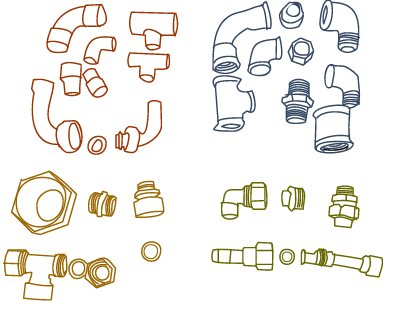 Fittings are used to connect different pipes and direct flows through plumbing systems.
Fittings are used to connect different pipes and direct flows through plumbing systems.

Types of common plumbing fittings
The various plumbing parts that join pipes are known as fittings. Fittings help to direct where pipes travel, and how the flow of the substances in the pipes travels. They may be threaded, barbed, soldered or glued to the pipes that are to be connected, depending on the purpose and on the types of pipes are that are being joined.
Fittings are made either of metal or a type of plastic. Some of the different fitting types include bushes, caps, couplings, crosses, bends, female adapters, male adapters, plugs, reducers, and tees.
Below is a basic explanation of what each of these is, and what function it serves:
- Bushings - Bushings are small pieces that are used to connect two pipes of different sizes together. A standard reducer bushing (sometimes simply referred to as a 'reducer') has one male end and one female connection.
- Caps - Caps are fittings that have a glued end or threaded end and the other end is closed off. This fitting is used to cap off (or 'terminate') a pipe.
- Couplings - Couplings connect two sections of pipe together. They may have glued ends or threaded ends.
- Crosses - Crosses are uncommon, but are fittings that join four sections of pipe at one point and may have glued ends or female thread ends. Note PVC crosses are glued ends only.
- Ells (or Elbows) - Ells change the direction of pipe. Ells are commonly 90 degree and 45 degree although specialty ells are available in other angles.
- Female adapters - Female adapters or sockets are used to adapt glued PVC to threaded or barbed connections.
- Male adapters or spigots are used to adapt from glued PVC to a male threaded end.
- Plugs - Plugs are used to plug an unused fitting outlet. Many plugs have female threaded ends, although some have glued ends. Threaded plugs are mostly intended for future connections at that particular area.
- Reducers change from one size pipe to another size pipe. The bell reducer has female threads on both ends and is generally not manufactured in PVC.
- Side outlet ells - Side outlet ells commonly have two ¾" or 1" glued sockets and ½" side outlets have female threads. These fittings are commonly used in residential sprinkler systems.
- Tees - The most common fitting is the 'tee', which is used to branch a side pipe off a pipeline. Tees are available with all female thread sockets, all glued sockets or with opposed glued and side outlet with female threads. This fitting is shaped like a "T".
How are fittings used?
The main purpose of fittings is to help change or stop the direction of the water (or gas) flow. Each plumbing fitting has a specific function to fulfil -for example, elbow joints allow pipe connections in different directions, and caps completely stop the flow at a given point.
The elbow joint (or 'ell') is the most common fitting. This can be fitted at a 45-degree or a 90-degree angle. Sinks make use of elbow joints or similar fixtures, in which the water flows into a drain leading to the septic tank or the sewer system. The ends of the elbow may be in the form of a socket or may be welded, and are sometimes threaded.
Tee joints either combine or divide the flow of water. Most tee joints are the same size on both ends, but for some the inlet and outlet sizes of the joint are different. This kind of joint is also known as a reducer joint.
Cross joints are used for sprinkler systems, because they have three inlet valves and one outlet valve or three outlet valves and one inlet valve. These fittings are expensive though, and rarely found in the home.
Besides joints, the other commonly used plumbing fittings are caps and plugs. If you want to close the end of a pipe, you can use a cap or a plug. A cap has to be fitted over the ends of the pipe and is screwed in by threading. Plugs fit into the end of a pipe. But both are generally well fixed so that no gas or water can pass through.
How are fittings tested?
Fittings, like the pipes they join, are bound by the National Plumbing and Drainage Code, AS3500 (parts 1 & 4), as well as any local water authority requirements. When pressure testing a new installation, AS3500 requires all installations to be hydrostatically tested. Hydrostatic testing involves filling the pipes with water at a certain pressure to check for leaks.
The recommended test pressure is 1500kPa, and the test should go for at least 30 minutes, in accordance with AS3500. Your plumber should disconnect any appliances or fittings that are not designed to withstand testing at 1500kPa.